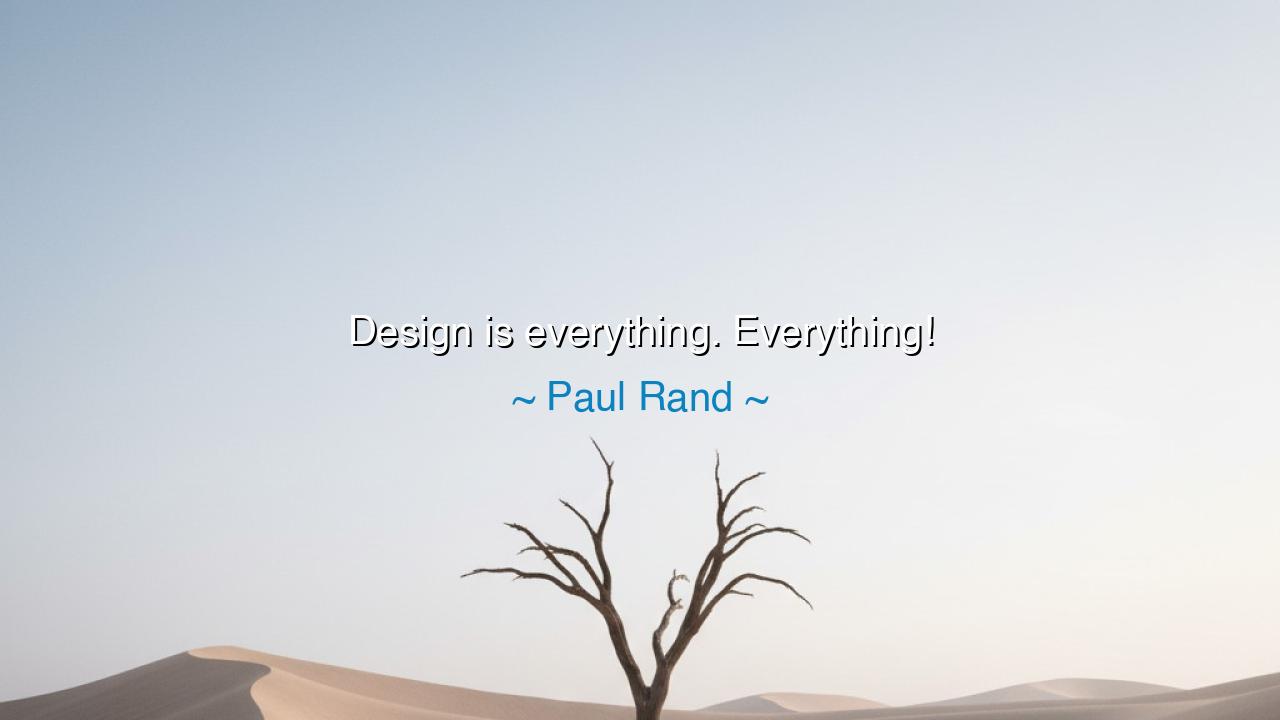
Design is everything. Everything!






“Design is everything. Everything!” — Paul Rand
Thus spoke Paul Rand, the visionary mind who reshaped the modern world through simplicity, intelligence, and beauty. In this thunderous declaration — “Design is everything. Everything!” — Rand did not speak of design merely as decoration or craft, but as the very structure of existence itself. For in his eyes, design was not confined to the artist’s studio or the architect’s table — it was the pattern that governs life, the invisible order behind all creation. To understand design, he believed, was to understand how the world itself is made to work — in form, in function, in purpose, and in soul.
The origin of these words lies in Rand’s long life as one of the fathers of modern graphic design. He brought logic and poetry to the field, shaping the identities of companies such as IBM, ABC, and UPS with marks so simple that they became eternal. To Rand, good design was not ornamentation but clarity — a way to distill truth into form. When he exclaimed that “design is everything,” he was reminding the world that every act of creation, every choice, every connection between human beings carries the imprint of design. From the curve of a chair to the rhythm of a sentence, from the movement of traffic to the architecture of ideas, all things are born of design — whether wise or careless, deliberate or accidental.
To design is to give shape to the unseen. It is the bridge between thought and reality. The ancients knew this truth well. When the builders of the Parthenon sought to embody harmony, they measured its columns not in random proportion, but according to divine geometry — the golden ratio that reflects the mathematics of the cosmos. Likewise, when the architects of the Gothic cathedrals raised their spires toward heaven, they were not merely constructing stone towers; they were designing an experience of awe. Every arch, every window, every beam of light was placed to evoke wonder — to make the invisible visible. Thus, the wisdom of Rand echoes across centuries: design governs not only what we see, but how we feel and who we become.
But Rand’s cry — “Everything!” — also speaks to the moral and spiritual dimension of design. For design is not neutral; it either uplifts or diminishes, enlightens or obscures. When a city is designed without care, its people grow weary; when a product is made without empathy, it frustrates instead of serves. Yet when design is guided by purpose, harmony, and respect, it ennobles human life. A well-designed book invites knowledge; a well-designed space inspires peace; a well-designed life fosters meaning. Rand saw that the designer’s duty — like that of the philosopher or the poet — was to bring order to chaos, to arrange the materials of the world in ways that reveal beauty, truth, and coherence.
History offers countless examples of this principle. Consider Steve Jobs, who, inspired by Rand’s philosophy, built Apple upon the belief that design and technology are one. Jobs once said that design is “not just what it looks like and feels like — design is how it works.” In this, he carried forward Rand’s wisdom: that the visible must serve the invisible, and that good design is the embodiment of thought made perfect. The iPhone, like Rand’s logos, is not merely an object — it is a conversation between human intention and human need, between the mind that envisions and the hand that shapes.
The lesson is this: everything you do, you design — whether consciously or not. Your words, your work, your home, your relationships — all are patterns you create, arrangements of energy and meaning. The question is not whether you design, but how you design. Do you build with care or with haste? With harmony or with chaos? The designer’s art is, in truth, the art of living: to see connections, to seek balance, to make beauty where once there was disorder. The wise do not leave design to chance; they understand that the smallest choices shape the largest outcomes.
So remember the teaching of Paul Rand: “Design is everything. Everything!” Let these words awaken the designer within you. For design is not a profession — it is a way of seeing, a way of being. It is the understanding that the world can be remade each day through thought, precision, and love. As you move through your life, design it well — with intention in your actions, compassion in your choices, and grace in your creations. For the universe itself is a masterpiece of design, and when you live as a designer, you take your rightful place as a co-creator in the grand pattern of all things.






AAdministratorAdministrator
Welcome, honored guests. Please leave a comment, we will respond soon